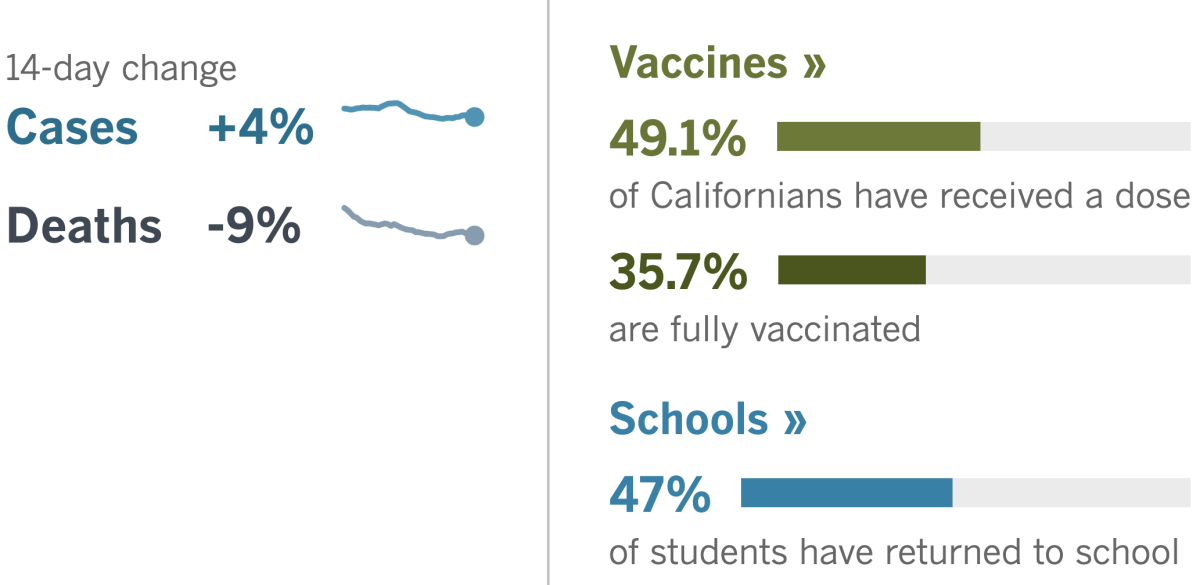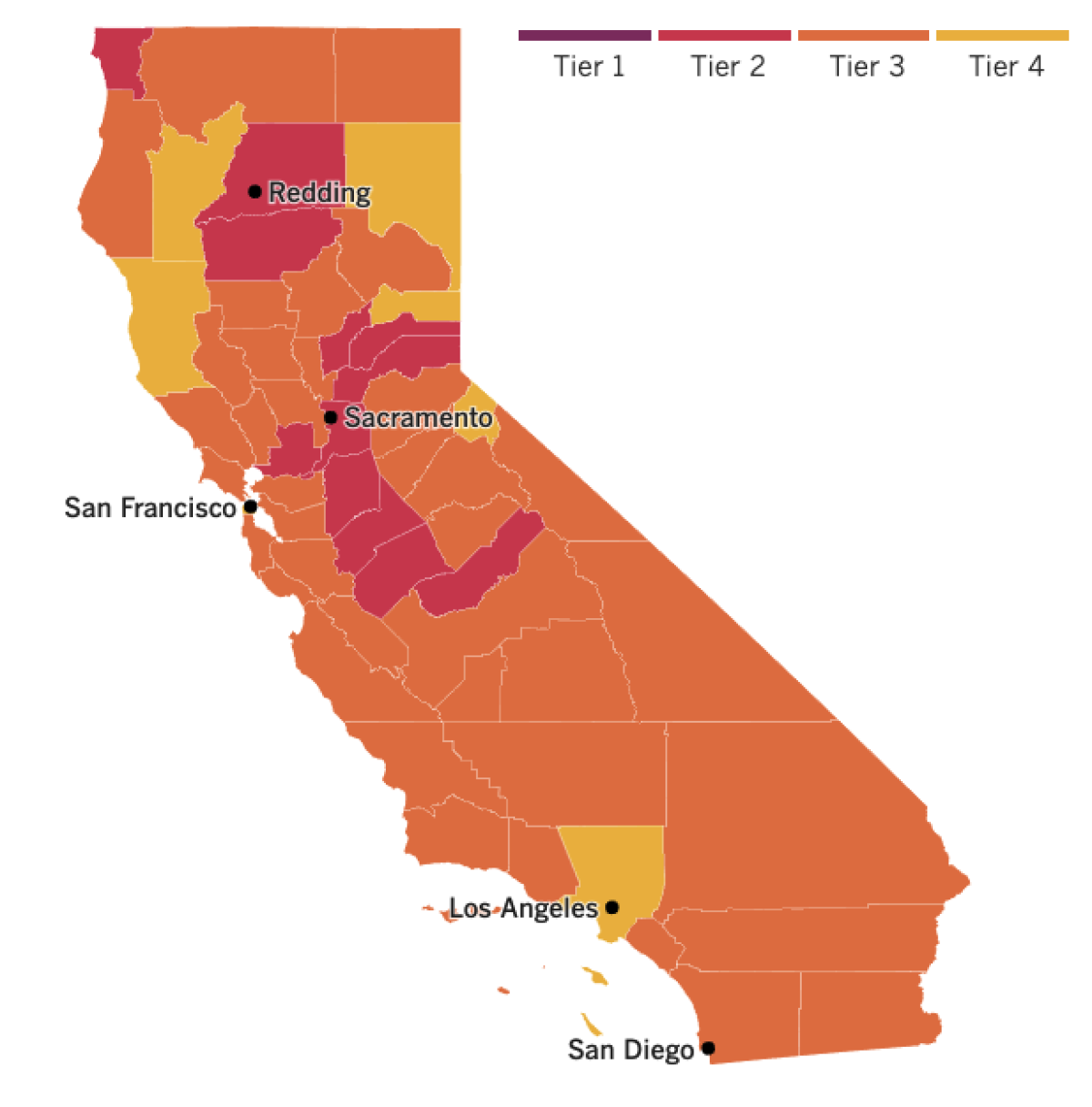Coronavirus Today: The vaccines are coming to you
Good evening. I’m Kiera Feldman, and it’s Monday, May 10. I’m an investigative reporter at The Times, and I’ll be bringing you the latest coronavirus news for the next couple of weeks. While some have pandemic fatigue and are eager to move on, that’s not me: I see the virus as our past, present and future, and I’m looking forward to diving in on the daily. With that in mind, here’s what’s happening in California and beyond.
California is finally bolstering its ground game for getting vaccines into arms.
In an effort that resembles a get-out-the-vote campaign, the Golden State is hiring 2,000 canvassers to work the phones and knock on doors, report my colleagues Laura J. Nelson and Maya Lau. And stay tuned for a flurry of ads and testimonials on television, radio and even TikTok.
The state is also expanding its efforts to target those who don’t have the resources that, to date, have proved necessary to get a vaccine in California: cars, reliable internet access, paid sick leave and trusted medical providers. Officials are coordinating free transportation, setting up kiosks outside high-traffic areas such as malls and train stations, and opening more clinics for walk-in appointments.
This boots-on-the-ground approach comes months after volunteers and community leaders set out to address vaccine inequities by enlisting grass-roots organizations to go door-to-door, hang fliers and canvass street vendors.
‚ÄúThe system isn‚Äôt working,‚ÄĚ Elizabeth Alcantar, the vice mayor of Cudahy, told The Times in March. ‚ÄúThe vaccines are going to folks who are more likely to have time, cars, internet, everything you need to get an appointment. We have to build access and ensure that people who typically don‚Äôt have access have access to these vaccines.‚ÄĚ
While the state’s get-out-the-vote vaccine campaign is coming a bit late in the game, such offline efforts may prove critical to reach the communities hardest hit by the coronavirus. The results from a recent survey were staggering: Nineteen percent of L.A. County households either have no internet connection or rely on smartphones, and nearly a quarter of Latinos are unconnected or restricted to smartphones.
If you’ve tried to book a vaccine appointment on your phone, you already know what officials should have anticipated: It can be impossible. Maddening, crazy-making impossible. (I’m fairly tech-savvy, and yet I failed miserably trying to navigate an online sign-up portal from my phone. I had to switch to a laptop.)
Racial disparities in vaccination remain pronounced in L.A. County. More than 50% of white and Asian American residents ages 16 and older have received at least one dose of vaccine, but only 30% of Latino and Black residents in the same age group have done so, according to county data.
‚ÄúWe‚Äôre getting to a point where, if you ask people to take the vaccine, if you have the vaccine right in front of them, they‚Äôll take it,‚ÄĚ said Dr. Richard Pan, a state senator and vaccine advocate. ‚ÄúBut you have to find them. They‚Äôre not going to come to you.‚ÄĚ
The California-wide push comes as President Biden is aiming to get a first dose to 70% of Americans by July 4. That ambitious goal may be out of reach in many parts of the country but could still be attainable in California, where nearly 50% of the population has already received at least one dose and vaccine skepticism is lower.
Getting another 20% of Californians vaccinated will be significantly harder, experts say ‚ÄĒ but it may still be possible with the right combination of incentives and persuasion.
‚ÄúIt is possible to have people change their mind,‚ÄĚ Whittier resident Andrew Reyna told The Times. ‚ÄúI‚Äôm able to tell people: ‚ÄėDude, just get it! I got it, I was skeptical at first, and it was fine. Now it‚Äôs your turn.‚Äô If they see someone like me doing it, they‚Äôll be inclined to do the same thing.‚ÄĚ
By the numbers
California cases, deaths and vaccinations as of 5:58 p.m. Monday:

Track California‚Äôs coronavirus spread and vaccination efforts ‚ÄĒ including the latest numbers and how they break down ‚ÄĒ with our graphics.

Across California
A pessimist at heart, I never truly believed we had any hopes of reaching herd immunity ‚ÄĒ the seemingly elusive point at which so many people have been inoculated or have natural immunity through exposure to the coronavirus that it runs out of places to spread. Experts warned that waning demand for the COVID-19 vaccines and uneven vaccination rates could thwart our chances of reaching that goal.
But on Monday, public health officials made a surprising announcement: Los Angeles County‚Äės adults and oldest teenagers could achieve herd immunity by mid- to late July.
The county has about 2 million first doses to go before 80% of all residents 16 and older will have received at least one shot, Los Angeles County Public Health Director Barbara Ferrer said Monday. If the county continues to administer 400,000 shots each week, then 80% of residents in this age group could get their second shot by mid- to late July, she said.
Her forecast doesn‚Äôt account for younger kids, including adolescents between the ages of 12 and 15 who on Monday became eligible to receive the Pfizer-BioNTech vaccine. (More on that later.) But it‚Äôs not a big problem for them to lag behind, she said, because ‚Äúchildren tend to be not as efficient spreaders as older teens and as adults are.‚ÄĚ
Parts of the Bay Area could reach herd immunity status by mid-June or early July, according to Dr. George Rutherford, an epidemiologist at UC San Francisco. The agricultural regions of the state would probably be last to achieve that milestone, he said.
Despite the progress with vaccinations and the steady decline in COVID-19 cases, students in the L.A. Unified School District are reluctant to return to campus.
According to district Supt. Austin Beutner, only 7% of high school students have returned to reopened campuses, along with 12% of middle schoolers and about 30% of elementary school children. The district had anticipated that more than twice as many middle and high school students would return.
There are multiple reasons for the low return rate. Parents from communities hard-hit during the winter surge were not confident that schools were safe. Others said they were put off by safety practices they consider unnecessarily extreme. And some parents and students said they either weren’t able to or didn’t want to change established routines so late in the school year, which ends June 11.
It‚Äôs not hard to see why high schoolers would say no to an arrangement that amounts to ‚ÄúZoom in a room.‚ÄĚ Returning to school in Los Angeles Unified means sitting in one classroom all day, with little intermingling or movement. (The format is the same for high schoolers in San Francisco as well.)
Take Patricia Francisco‚Äôs class at Panorama High School. During the first week of in-person learning, the drama teacher spoke into a camera to address her students over Zoom. There were only three kids in her classroom ‚ÄĒ and they were attending other online classes while wearing noise-canceling headphones.
Figuring out how to reopen elementary schools was simpler: Each student has just one class for the entire day. But administrators have struggled to plan around the complicated schedules of older students, who move from classroom to classroom throughout the day.
They might get some tips from Long Beach Unified, where about 37% of high school students have returned to campus.
At Millikan High School in East Long Beach, five of the 32 students in Andrea Glenn‚Äôs ‚ÄúJustice in America‚ÄĚ class attend in-person while the rest participate via Zoom. Teaching both ways at the same time ‚Äúis exhausting,‚ÄĚ she said, but it has its rewards.
‚ÄúA couple of them were giggling about something, and it made me so happy just to hear students laughing,‚ÄĚ she said. ‚ÄúI missed that noise.‚ÄĚ


See the latest on California’s coronavirus closures and reopenings, and the metrics that inform them, with our tracker.
Consider subscribing to the Los Angeles Times
Your support helps us deliver the news that matters most. Become a subscriber.
Around the nation and the world
The U.S. Food and Drug Administration on Monday authorized the Pfizer-BioNTech COVID-19 vaccine for use in kids ages 12 to 15. That‚Äôs sure to be welcome news for adolescents ‚ÄĒ and their parents ‚ÄĒ who have been waiting anxiously for this cohort to be eligible for the shot.
Although kids in this age group account for only about 5% of the U.S. population, they can help move the nation closer to herd immunity by agreeing to get vaccinated, my colleague Deborah Netburn reports.
‚ÄúThe path to beating this virus is taking lots of small steps,‚ÄĚ said Dr. David Dowdy, an infectious disease epidemiologist at Johns Hopkins University. ‚ÄúThis is one of those small steps.‚ÄĚ
The FDA action comes amid mounting evidence that COVID-19 vaccines are holding up well against coronavirus variants, and experts are expressing increasing confidence in the shots, my colleague Rong-Gong Lin II reports.
Studies indicate the vaccines work well against the two most dominant strains in California ‚ÄĒ the one first identified in the United Kingdom (B.1.1.7) and the homegrown strain identified in California (B.1.427/B.1.429).
What’s more, new data from overseas show that the Pfizer-BioNTech and Moderna vaccines provide very good coverage against B.1.117 and the variant first identified in South Africa (B.1.351).
In a large study in Qatar, two doses of the Pfizer vaccine proved to be 89.5% effective against any documented infection with B.1.117, and 75% effective in cases involving B.1.351. The Pfizer vaccine was 100% effective against severe illness and death, according to data published in the New England Journal of Medicine and presented to reporters on Friday by Dr. Anthony Fauci.
In Israel, both doses of the Pfizer vaccine were 95.3% effective against coronavirus infection, Fauci said, citing data published in the Lancet.
In Brazil, a variant known as P.1 is thought to be responsible for a second COVID-19 surge that has pushed that country‚Äôs death toll over 422,000. However, data show that ‚Äúin the lab, the vaccines we have now worked quite well against P.1,‚ÄĚ said Dr. Eric Topol, director of the Scripps Research Translational Institute in La Jolla. Finally, there are early indications that vaccines are effective against a variant first reported in India, a country in the throes of a devastating surge.
This is all reassuring news for Americans, where vaccine stockpiling has made doses so readily available that supply is now outpacing demand. But nearly a dozen countries ‚ÄĒ many of them in Africa ‚ÄĒ are still waiting to get vaccines, according to the World Health Organization.
‚ÄúDelays and shortages of vaccine supplies are driving African countries to slip further behind the rest of the world in the COVID-19 vaccine rollout, and the continent now accounts for only 1% of the vaccines administered worldwide,‚ÄĚ the WHO warned Thursday.
The European Union, meanwhile, agreed to increase its purchase of the Pfizer-BioNTech vaccine to 900 million doses, with an option to add another 900 million through 2023. The decision underscores the confidence the EU has shown in the technology used for the Pfizer-BioNTech vaccine.
The European Commission currently has a portfolio of 2.6 billion doses from half a dozen companies.
In other news, a judge struck down a nationwide eviction moratorium last week, and now housing advocates are warning that billions of dollars in federal aid won’t reach people in time to prevent a widespread housing crisis.
The eviction moratorium, imposed last year as a pandemic measure by the federal Centers for Disease Control and Prevention, expires June 30. Congress allocated nearly $50 million for rental assistance, but advocates say few tenants have received the money ‚ÄĒ and there‚Äôs little hope it‚Äôll reach those in need fast enough.
Nearly 4 million people in the U.S. face eviction or foreclosure in the next two months, according to the Census Bureau’s biweekly Household Pulse Survey.
Your questions answered
Today’s question comes from readers who want to know: How do I get the COVID-19 vaccine in Los Angeles now that appointments are no longer required?
Just a few months ago, the struggle to get a dose of vaccine in L.A. was reminiscent of ‚ÄúLord of the Flies.‚ÄĚ But now, finding a shot is easier than ever.
Starting today, appointments are no longer needed for Angelenos to get COVID-19 vaccinations at any site run by the city.
All L.A. County residents age 16 years and older are eligible, regardless of immigration status. Vaccinations are free. Just show up. All you need is a photo ID and proof that you are at least 16, per county guidelines.
County officials say they‚Äôre ‚Äúwaiting for further guidance‚ÄĚ before they start giving the Pfizer-BioNTech vaccine to younger adolescents, but it‚Äôs possibly they could start getting shots later this week.
If you’re already in the right age group, you can find vaccination locations near you, look up hours of operations, and see which sites are walk-up and drive-through on the city’s website.
The city also offers mobile vaccination sites that change weekly. Be sure to check this week’s current locations and hours.
Some mobile sites also offer extended hours from 9 a.m. through 8:45 p.m. The city also has extended hours at Pierce College and L.A. Southwest College, which are open from 8 a.m. until 8 p.m.. A third night clinic is being added at Green Meadows Recreation Center in South L.A. this week and will be open from 9 a.m. to 9 p.m., the city announced.
Need a late-night vaccine? Kedren Health is providing the vaccine without an appointment until midnight at its South L.A. location from Monday through Friday (and Saturdays from 9 a.m. to 4 p.m.).
Appointment-free options are also available at the city‚Äôs drive-through sites ‚ÄĒ the Crenshaw Christian Center, Hansen Dam and Dodger Stadium ‚ÄĒ which are open Monday through Saturday. People can still sign up for a drive-through or walk-in appointment ahead of time if they prefer, either online or by calling 1-833-540-0473.
We want to hear from you. Email us your coronavirus questions, and we’ll do our best to answer them. Wondering if your question’s already been answered? Check out our archive here.
Resources
Need a vaccine? Sign up for email updates, and make an appointment where you live: City of Los Angeles | Los Angeles County | Kern County | Orange County | Riverside County | San Bernardino County | San Diego County | San Luis Obispo County | Santa Barbara County | Ventura County
Need more vaccine help? Talk to your healthcare provider. Call the state’s COVID-19 hotline at (833) 422-4255. And consult our county-by-county guides to getting vaccinated.
Practice social distancing using these tips, and wear a mask or two.
Watch for symptoms such as fever, cough, shortness of breath, chills, shaking with chills, muscle pain, headache, sore throat and loss of taste or smell. Here’s what to look for and when.
Need to get tested? Here’s where you can in L.A. County and around California.
Americans are hurting in many ways. We have advice for helping kids cope, resources for people experiencing domestic abuse and a newsletter to help you make ends meet.
We’ve answered hundreds of readers’ questions. Explore them in our archive here.
For our most up-to-date coverage, visit our homepage and our Health section, get our breaking news alerts, and follow us on Twitter and Instagram.




